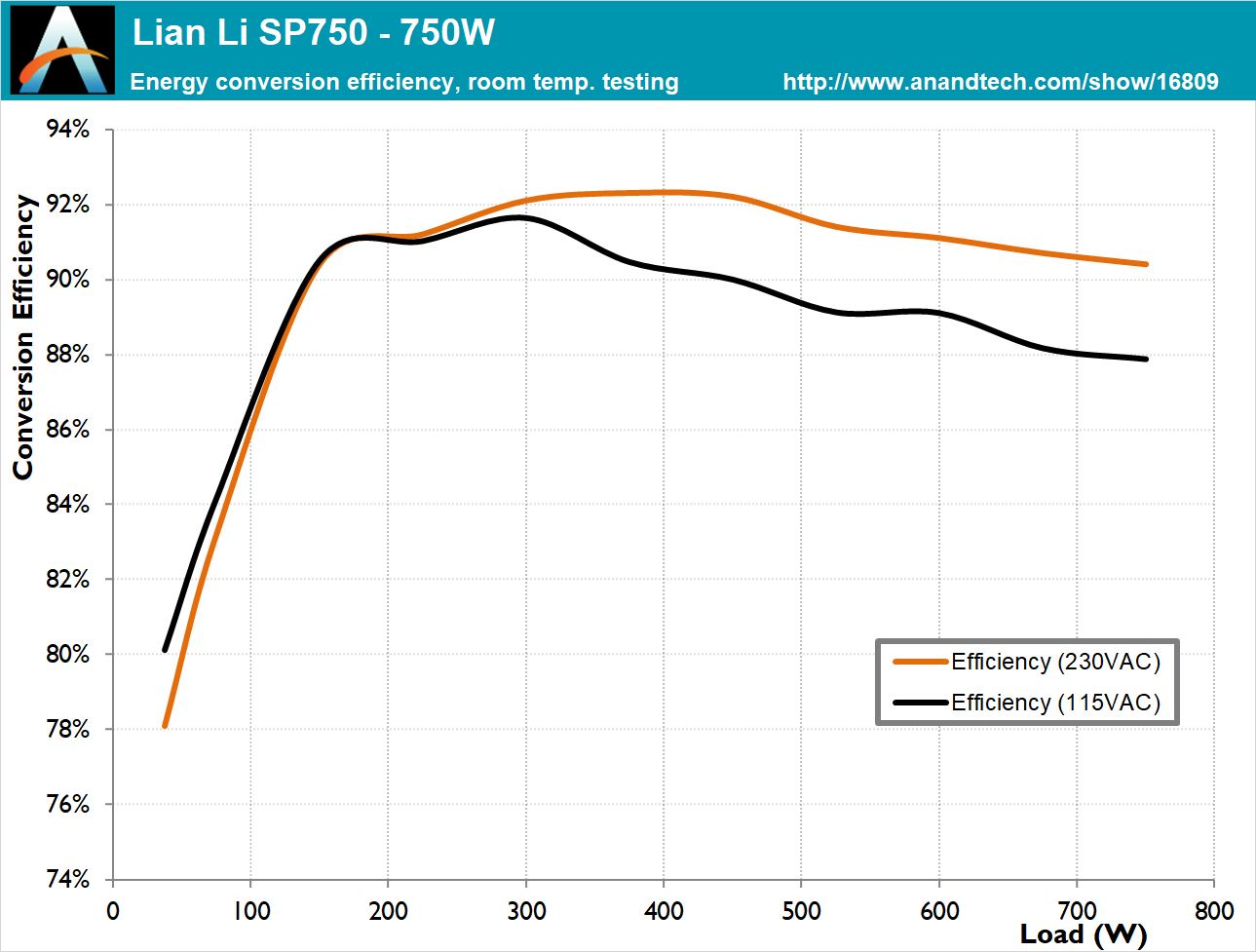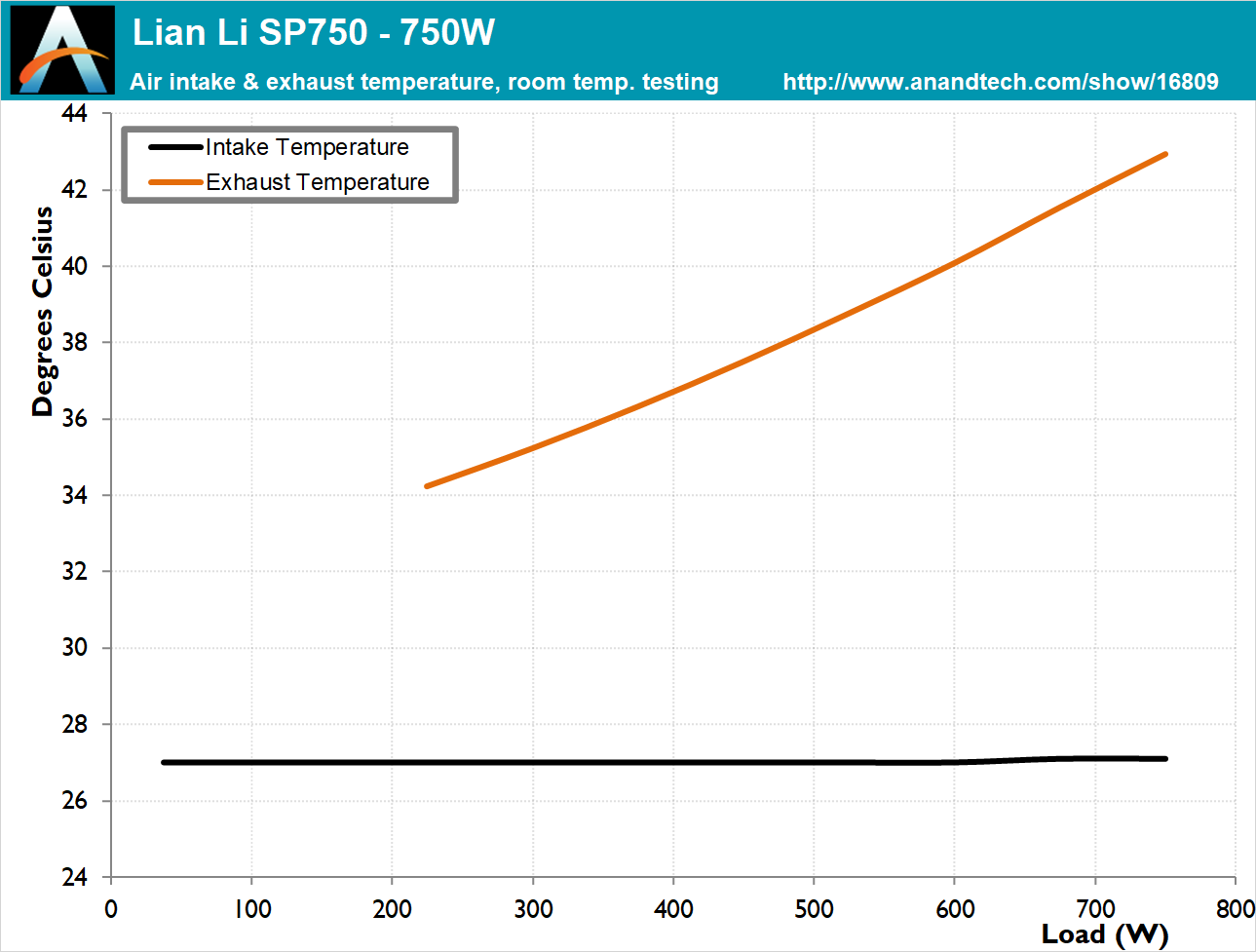The SP750 SFX Gold Review: Lian Li's First SFX Power Supply
by E. Fylladitakis on July 12, 2021 9:00 AM EST- Posted in
- Cases/Cooling/PSUs
- PSUs
- 80Plus Gold
- 750W
- SFF
- Lian Li
- SFX
- SP750
Cold Test Results (Room Ambient Temperature)
For our power supply testing, we are using high precision electronic loads with a maximum power draw of 2700 Watts, a Rigol DS5042M 40 MHz oscilloscope, an Extech 380803 power analyzer, two high precision UNI-T UT-325 digital thermometers, an Extech HD600 SPL meter, a self-designed hotbox and various other bits and parts. For a thorough explanation of our testing methodology and more details on our equipment, please refer to our How We Test PSUs post.
The efficiency of the Lian Li SP750 is good – and it had to be, considering the very high output and its small size. The unit meets the 80Plus Gold certification limit of 90% efficiency at 20% load when powered from a 230V AC source. When powered from a 115V AC source, the low load efficiency is actually even higher, easily granting the SP750 its 80Plus Gold certification. The average efficiency of the SP750 across its nominal load range is 91.3% when powered from a 230V AC source, or 89.7% when powered from a 115V AC source.
Lian Li has the SP750 designed so as to operate without turning on its fan up to 40% load (300 Watts). To be exact, the thermal control of the PSU is tuned so as to turn on the fan when the internal temperature of the unit reaches 60°C. At a room temperature of 25°C, that would happen when the load is about 300 Watts, hence Lian Li’s specification. With our higher room temperature, the fan started earlier, with the thermal control circuit starting the fan almost exactly at an internal temperature of 60°C.
The 92 mm fan started when our load was just over 200 Watts, with relatively low noise figures for a fan this size. Its double ball bearing engine is audible just as soon as the fan starts but stays at comfortable levels unit the load reaches about 550 Watts. At higher loads, the fan will be clearly audible from a distance, yet not unexpectedly so all things considered.















29 Comments
View All Comments
meacupla - Tuesday, July 13, 2021 - link
okay, in that case, I want to see someone's matx, sfx, dgpu compute pc then.Spunjji - Tuesday, July 13, 2021 - link
It does sound like a niche within a niche (within a niche)Questor - Tuesday, July 13, 2021 - link
I don't have a picture of one. I can tell you they exist. Go to Small Form Factor dot net and there you will find SFF cases designed for bifurcation of the single PCIexpress slot. There are riser cables designed for it as well. It certainly has nothing to do with playing games. It is a real thing though I agree a special situation scenario.thestryker - Monday, July 12, 2021 - link
While I'm fairly confident that the PSU would last a long time the warranty period is disconcerting. Now this might just be due to the contract Lian Li signed with the ODM, but even the midrange PSU I got 5 years ago for my system came with a 10 year warranty. If this foray is successful for Lian Li it will be interesting to see if they go back and lengthen the warranty.As always I really appreciate the quality of the PSU reviews done here, and the high ambient testing brings in a unique dynamic.
jonnyGURU - Monday, July 12, 2021 - link
Lian Li's first PSU? Lian Li has had PSUs since 2008!!! They literally have two SFX-L PSUs on the market that were launched just five years ago! LOL!kaidenshi - Tuesday, July 13, 2021 - link
You may wish to re-read the article instead of skimming. This is their first non-L SFX PSU. Their SFX-L models were addressed in the article:"A few years ago, it entered the market with SFX-L power supplies, but the demand wasn't quite there."
Oxford Guy - Tuesday, July 13, 2021 - link
The fan is a mistake.Ball bearing fans have no place outside of radiators in consumer systems and even then it's questionable.
I have also read the claims that they are more prone to damage if they are knocked hard or dropped — and that they become noisier over time (unlike FDB and other high-quality alternatives). I am not sure if either are true but the noise performance of this unit, fresh and undamaged, is enough to show that the fan is a mistake.
Spunjji - Tuesday, July 13, 2021 - link
I believe they've gone for the least expensive option that would still survive the high temperature environment inside a small PSU. Sleeve bearing fans die too quickly in such circumstances, and anything resembling FDB probably involves the sort of cost increase they'd want to avoid.Personally I'd be happy enough replacing the fan myself if the noise became an issue, but it's a shame for the sort of end users who rely on warranties.
Oxford Guy - Tuesday, July 13, 2021 - link
‘anything resembling FDB probably involves the sort of cost increase they'd want to avoid.’The company clearly did want to avoid it. The consumer can avoid the product in return.
Samus - Tuesday, July 13, 2021 - link
As an EE, this thing is practically pornography for me. Beautiful unit.